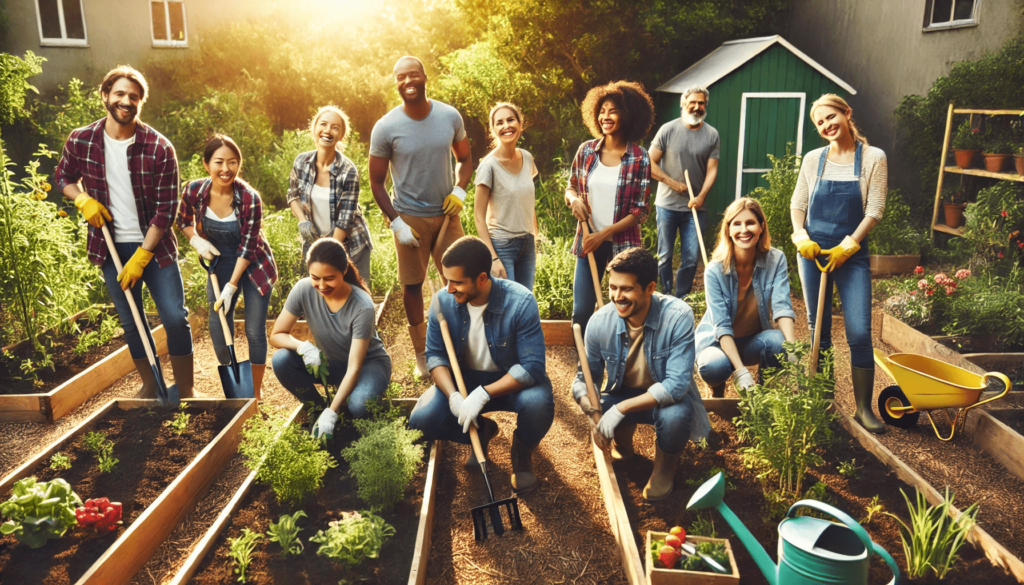The Power of Giving Back: Why Community-Led Projects Matter

Communities thrive when people take action.
The strongest communities aren’t built by governments or corporations. They’re built by the people who live there.
In this post, we’ll dive into why community-led projects matter and highlight how initiatives like tool libraries, food co-ops, and youth mentorship programs can empower neighborhoods, create opportunities, and strengthen social ties.
Why Grassroots Action Beats Top-Down Policies
When solutions come from within communities rather than being imposed from above, several powerful advantages emerge:
1. Local Knowledge Leads to Better Solutions
Residents understand neighborhood needs in ways outsiders never can. They know which intersections feel dangerous after dark, which families struggle during school breaks when free lunches aren’t available, and which unused spaces have potential. This intimate knowledge leads to targeted, effective solutions.
2. Sustainable Change Requires Community Ownership
External programs often falter when funding cycles end or priorities shift. Community-owned initiatives persist because residents have personal investment in their success. When people build something themselves, they fight to sustain it.
3. The Process Itself Creates Connection
Professional service delivery can be efficient but impersonal. When neighbors work together to address community needs, the collaboration builds relationships that extend beyond the project itself. The social capital generated becomes a resource for future challenges.
4. Skills and Confidence Grow Through Action
Community-led initiatives develop local leadership, project management skills, and civic confidence. These capacities spill over into other areas of community life and personal development.
Community Initiatives That Transform Neighborhoods
Let’s explore how different types of community-led projects can address specific needs while building broader unity:
Tool Libraries: Sharing Resources, Building Skills
Tool libraries function like book libraries but for equipment—from power tools to kitchen appliances to gardening supplies. These community resources:
- Make expensive items accessible to everyone
- Reduce consumption and environmental impact
- Create natural skill-sharing opportunities
- Transform the culture from ownership to stewardship
Success Story: The Berkeley Tool Lending Library, started in 1979 with a small collection of donated tools, now houses over 3,500 tools and serves thousands of community members annually. Beyond tool access, it’s become a hub for workshops, home repair advice, and intergenerational knowledge transfer.
Food Co-ops: Nourishing Bodies and Economic Justice
Community-owned food cooperatives provide more than fresh food—they create democratic economic models where:
- Members collectively own and govern the enterprise
- Local farmers and producers find reliable markets
- Food accessibility improves in underserved areas
- Profits recirculate within the community
Success Story: The Mandela Grocery Cooperative in West Oakland transformed a food desert into a hub for health and economic opportunity. Worker-owned by neighborhood residents, the co-op provides affordable fresh produce, nutrition education, and quality jobs while keeping dollars circulating in the local economy.
Youth Mentorship Programs: Investing in the Future
Community-organized mentorship programs connect young people with caring adults who provide guidance, support, and expanded horizons. These relationships:
- Build resilience and reduce risk behaviors
- Expose youth to diverse career paths
- Create cross-generational understanding
- Develop future community leaders
Success Story: Chicago’s “My Block, My Hood, My City” program began when a single resident, Jahmal Cole, started taking teenagers from his neighborhood to explore other parts of Chicago. This simple act of exposure has grown into a movement connecting youth with mentors who help them discover opportunities while engaging in community service projects.
How Giving Back Builds Sustainable Communities
Community-led initiatives create multiple layers of positive impact:
The Reciprocity Effect
When people experience their community supporting them, they become more likely to contribute in turn. This creates virtuous cycles of giving and receiving that strengthen social cohesion.
Beyond the Transactional Economy
Community projects introduce alternative economic models based on relationships rather than just transactions. The time bank movement, for example, allows people to exchange services based on time contributed rather than market rates, recognizing that everyone’s time has equal value.
Resilience Through Diversity
When communities develop multiple, overlapping projects addressing different needs, they build resilience. If one initiative struggles, others continue functioning, maintaining the web of support that defines strong communities.
The Multiplier Effect
Success breeds success. Communities with even one thriving resident-led initiative are more likely to develop others as people experience their collective power to create change.
Starting Your Own Community Project
Ready to contribute to your community’s strength? Here’s how to begin:
1. Start With Listening, Not Solutions
Before launching any initiative, spend time understanding community needs and assets through:
- Informal conversations with diverse residents
- Community mapping exercises
- Open forums for idea-sharing
- Surveys of existing resources and gaps
2. Build a Core Team With Complementary Skills
Look beyond the usual suspects to include:
- People with lived experience of the issues you’re addressing
- Those with relevant technical or professional knowledge
- Natural connectors who can bring others into the work
- Detail-oriented implementers who follow through
3. Start Small and Demonstrate Success
Begin with achievable projects that show visible results:
- A one-day community cleanup
- A skill-sharing workshop series
- A small community garden plot
- A neighborhood celebration
4. Document and Celebrate Progress
Create momentum by:
- Sharing stories across multiple platforms
- Recognizing all contributors, not just leaders
- Capturing lessons learned for future projects
- Connecting your work to broader community narratives
Join the Movement
Community-led initiatives aren’t just nice additions to neighborhood life—they’re essential to creating the supportive, connected communities we all deserve. When we move from being passive consumers of services to active co-creators of our shared environment, we transform not just our neighborhoods but ourselves.
On the Path to Unity, giving back isn’t charity—it’s the practical, everyday work of weaving a community fabric strong enough to hold us all.
What skills, passions, or resources could you contribute to a community project today?






Responses